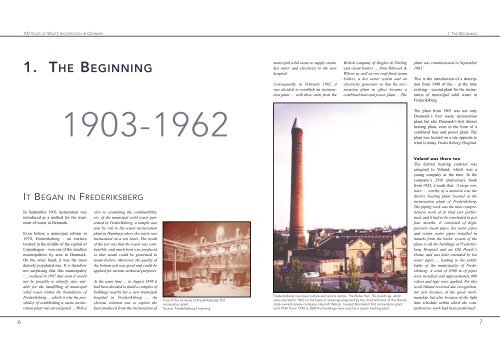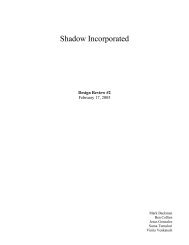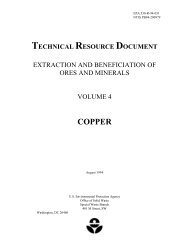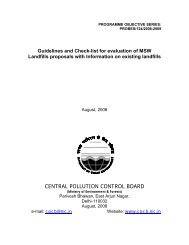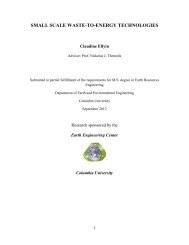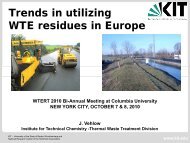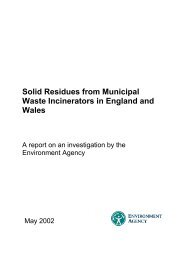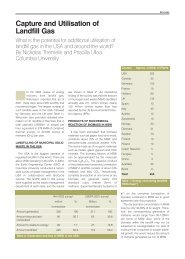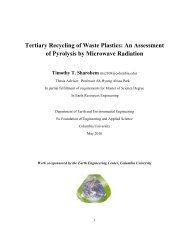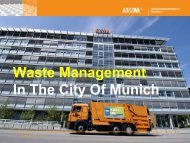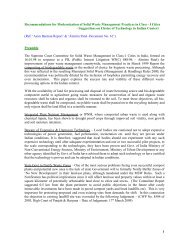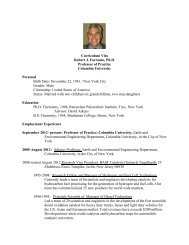100 YEARS OF WASTE INCINERATION IN DENMARK
100 YEARS OF WASTE INCINERATION IN DENMARK
100 YEARS OF WASTE INCINERATION IN DENMARK
You also want an ePaper? Increase the reach of your titles
YUMPU automatically turns print PDFs into web optimized ePapers that Google loves.
<strong>100</strong> <strong>YEARS</strong> <strong>OF</strong> <strong>WASTE</strong> <strong><strong>IN</strong>C<strong>IN</strong>ERATION</strong> <strong>IN</strong> <strong>DENMARK</strong><br />
1. THE BEG<strong>IN</strong>N<strong>IN</strong>G<br />
1. THE BEG<strong>IN</strong>N<strong>IN</strong>G<br />
municipal solid waste to supply steam,<br />
hot water and electricity to the new<br />
hospital.<br />
Consequently, in February 1902, it<br />
was decided to establish an incineration<br />
plant … with three units from the<br />
British company of Hughes & Stirling<br />
and steam boilers … from Babcock &<br />
Wilcox as well as two coal-fired steam<br />
boilers, a hot water system and an<br />
electricity generator so that the incineration<br />
plant in effect became a<br />
combined heat and power plant … The<br />
plant was commissioned in September<br />
1903’.<br />
This is the introduction of a description<br />
from 1948 of the – at the time<br />
existing – second plant for the incineration<br />
of municipal solid waste in<br />
Frederiksberg.<br />
1903-1962<br />
The plant from 1903 was not only<br />
Denmark’s first waste incineration<br />
plant, but also Denmark’s first district<br />
heating plant, even in the form of a<br />
combined heat and power plant. The<br />
plant was located on a site opposite to<br />
what is today Frederiksberg Hospital.<br />
IT BEGAN <strong>IN</strong> FREDERIKSBERG<br />
In September 1903 incineration was<br />
introduced as a method for the treatment<br />
of waste in Denmark.<br />
Even before a municipal reform in<br />
1970, Frederiksberg – an enclave<br />
located in the middle of the capital of<br />
Copenhagen – was one of the smallest<br />
municipalities by area in Denmark.<br />
On the other hand, it was the most<br />
densely populated one. It is therefore<br />
not surprising that this municipality<br />
‘… realised in 1897 that soon it would<br />
not be possible to identify sites suitable<br />
for the landfilling of municipal<br />
solid waste within the boundaries of<br />
Frederiksberg … which is why the possibility<br />
of establishing a waste incineration<br />
plant was investigated … With a<br />
view to examining the combustibility<br />
etc. of the municipal solid waste generated<br />
in Frederiksberg, a sample was<br />
sent by rail to the waste incineration<br />
plant in Hamburg where the waste was<br />
incinerated on a test basis. The result<br />
of the test was that the waste was combustible,<br />
and much heat was produced<br />
so that steam could be generated in<br />
steam boilers. Moreover, the quality of<br />
the bottom ash was good and could be<br />
applied for various technical purposes.<br />
At the same time … in August 1898 it<br />
had been decided to build a complex of<br />
buildings nearby for a new municipal<br />
hospital in Frederiksberg … An<br />
obvious solution was to exploit the<br />
heat produced from the incineration of<br />
One of the furnaces at Frederiksberg’s first<br />
incineration plant.<br />
Source: Frederiksberg Forsyning.<br />
Frederiksberg municipal culture and sports centre, The Boiler Hall. The buildings, which<br />
were erected in 1903 on the basis of drawings prepared by the chief architect of the Danish<br />
state-owned railway company, Heinrich Wenck, housed Denmark’s first incineration plant<br />
until 1934. From 1934 to 2000 the buildings were used as a steam heating plant.<br />
Vølund was there too<br />
The district heating contract was<br />
assigned to Vølund, which was a<br />
young company at the time. In the<br />
company’s 25th anniversary book<br />
from 1923, it reads that: ‘A large contract<br />
… worthy of a mention was the<br />
district heating plant located at the<br />
incineration plant of Frederiksberg.<br />
The piping work was the most comprehensive<br />
work of its kind ever performed,<br />
and it had to be concluded in just<br />
four months. It consisted of highpressure<br />
steam pipes, hot water pipes<br />
and return water pipes installed in<br />
tunnels from the boiler system of the<br />
plant to all the buildings at Frederiksberg<br />
Hospital and an Old People’s<br />
Home, and was later extended by hot<br />
water pipes … leading to the public<br />
baths of the municipality of Frederiksberg.<br />
A total of 8500 m of pipes<br />
were installed and approximately 800<br />
valves and taps were applied. For this<br />
work Vølund received due recognition,<br />
not just because of the good workmanship,<br />
but also because of the tight<br />
time schedule within which the comprehensive<br />
work had been performed’.<br />
6<br />
7


